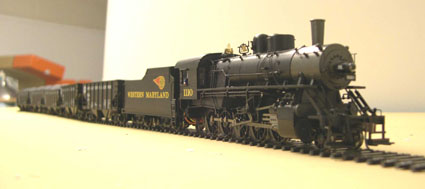

InspirationOf all the aspects of model railroading, sometimes deciding just what to model can be the most difficult of decisions. |
 |
As with many, I began long ago with a loop of track and some turnouts on a table in my parent's basement. The track was arranged to a John Armstrong plan published in an Atlas track plan book. I joined a local model railroad club at age 15 and helped build a large model railroad influenced by railroads in western Pennsylvania, but it had a fictitious name and connected fictitious towns. The narrow gauge bug hit shortly afterwards. Eastern narrow gauge railroads were the draw, especially the East Broad Top, the Waynesburg & Washington, and the Tionesta Valley. A few narrow gauge layouts were designed and one progressed to construction incorporating elements of several different narrow gauge prototypes. It was placed along the same right-of-way as the Cambria & Indiana Railroad in western Pennsylvania, but it had a different name and “historical” background.
I moved to Morgantown, W. Va., in 1985 and joined the Mon Valley Railroad Club of West Virginia in 1988. A couple of club layouts have been designed and built. The latest is set in a specific geographic area of the Mountain State, but is a fictitious railroad borrowing elements of other West Virginia railroads and industries. After a move to a new home in 2000, I had the opportunity to design and build my own railroad. But I was stuck. I didn’t know quite what to do.
Where does my inspiration come from?
That’s what my layout design thoughts boiled down to a few years ago. In the late 1980’s, I had discovered the West Virginia and Regional History Collection of the West Virginia University library. Photos, maps, newspapers, government documents, and so much more were all in one part of the library. It was a gold mine of historical information that began to turn my attention to the rich industrial history of the state and immediate area where I lived. Discovering details of the glass industry led to a clinic presentation at a National Model Railroad Association convention held in Morgantown in 1999. Combining elements of this interesting industry with the rail structure and service of the late 1940’s inspired a model railroad track plan for a spare 12x12 foot bedroom. The clinic ended up being published in Model Railroad Planning 2001.
Details on other local towns became very interesting to me. Morgantown, Elkins, Thomas, Fairmont, Parsons, Clarksburg, and Grafton all contained elements of railroads and industry that held my interest. I began to realize my interests were drawn more to the areas where the railroad served local industry and the local businesses that fed and clothed the populace. The warehouse districts or the freight house, or where the wholesale grocers were clustered. This was where there was action on the railroad almost every day from the tie the railroad came to town until the early 1960’s. Several towns also featured junctions with other railroads, or junctions with subdivisions of the main railroad. Again, this is where the action was as trains left or entered the mainline.
During this time the Western Maryland Railway was drawing myinterest. A bike ride on the old Blackwater canyon grade in 1995 was a big influence, and the railroad was a staple in national model and prototype railroad magazines. The stretch from Thomas to Elkins had many desirable features to incorporate into a model railroad design, but I would never have adequate space to do justice to this 35 mile stretch of railroad. At some point, my realizations on junctions, local industry and business, and the Western Maryland Railway began merging together. All of these parts came together well in Elkins, but not the part of Elkins model railroaders and railfans are familiar with. The junctions and local industry were in South Elkins, across the Tygart Valley River from the depot, engine facilities and main yard. I felt I had the space to model South Elkins, but not the main yard and depot area.
Here are a few pages with South Elkins industrial information.
Railroad Avenue Industries
Livingston Avenue Industries
Elkins Tannery
Direct your comments and/or questions to: 43admin@hansmanns.org
All content and images copyright 2006 by EWHansmann, unless otherwise indicated.